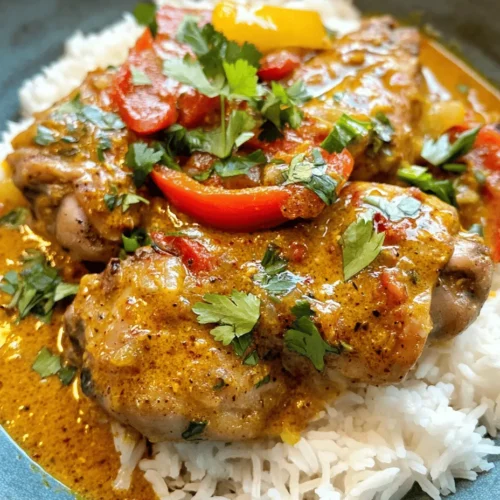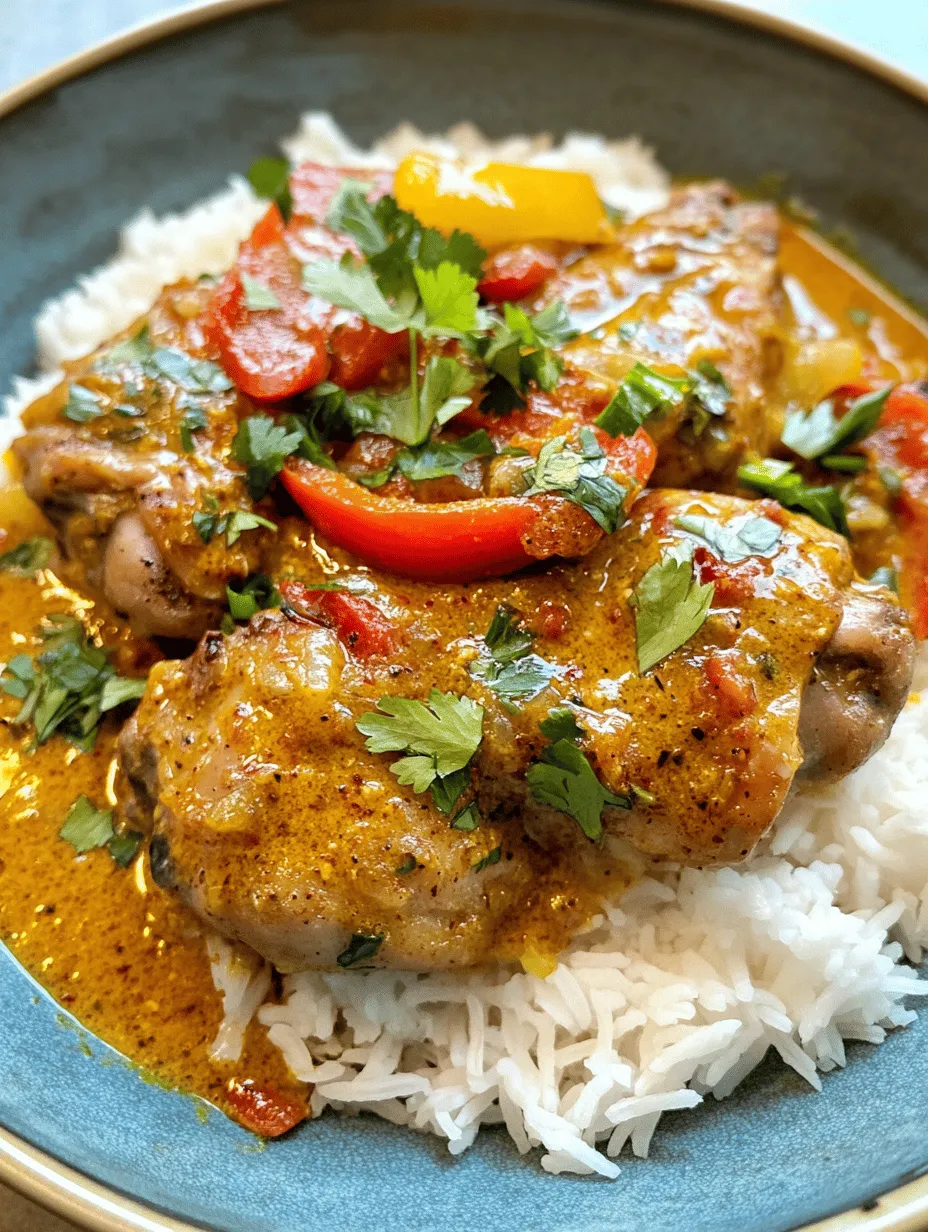Introduction
Brazilian cuisine is a rich tapestry of diverse flavors, textures, and influences, drawing from the country’s indigenous roots, Portuguese colonization, and African heritage. Known for its vibrant dishes that often feature bold spices, fresh ingredients, and a fusion of culinary traditions, Brazilian food has captivated taste buds worldwide. One dish that exemplifies this flavorful amalgamation is Spicy Brazilian Coconut Chicken, a delightful recipe that embodies the essence of Brazil’s culinary landscape.
Spicy Brazilian Coconut Chicken, or “Frango com Coco e Pimenta” as it is known in Portuguese, is a sumptuous dish that combines the creaminess of coconut milk with a medley of spices and the warmth of Brazilian chili paste, known as pimenta. This dish strikes a perfect balance between spice and creaminess, making it a versatile option that can be enjoyed for family dinners or served at gatherings to impress guests. The melding of flavors creates a comforting yet exciting meal that showcases the heart of Brazilian cooking.
Central to this dish is the use of coconut milk and a selection of spices that not only enhance the taste but also reflect the culinary traditions of Brazil. Coconut milk is a staple in many Brazilian recipes, adding a luscious creaminess that perfectly complements the heat from the spices. The use of spices such as cumin and turmeric not only contributes to the flavor profile but also offers health benefits, making this dish a nourishing choice for any occasion.
In this article, we will delve deeper into the ingredients that make this recipe special and provide step-by-step instructions to ensure it turns out delicious every time.
Understanding the Ingredients
Chicken Thighs: Why They Are Preferred for This Recipe
When it comes to selecting the right cut of chicken for Spicy Brazilian Coconut Chicken, chicken thighs are the preferred choice. Unlike chicken breast, which can dry out quickly during cooking, chicken thighs are more forgiving due to their higher fat content. This results in juicier, more flavorful meat that holds up well in rich sauces. The inherent tenderness of chicken thighs also allows them to absorb the flavors of the marinade and sauce more effectively, providing a satisfying bite in every mouthful.
Coconut Milk: Its Role in Adding Creaminess and Flavor
Coconut milk is a star ingredient in this dish, providing a velvety texture and a subtle sweetness that balances the heat of the spices. Made from the flesh of mature coconuts, coconut milk is rich in healthy fats, vitamins, and minerals. In Brazilian cuisine, it is commonly used to enhance the flavor of stews, curries, and desserts. In our Spicy Brazilian Coconut Chicken, coconut milk acts as the base for the sauce, enveloping the chicken and aromatics in a creamy embrace that makes each bite comforting and satisfying.
Brazilian Chili Paste: Explanation of Pimenta and Its Significance in Brazilian Recipes
No Brazilian dish would be complete without the heat and flavor of pimenta, a Brazilian chili paste that plays a crucial role in achieving the signature spiciness of this recipe. Pimenta can vary in heat levels and flavors, depending on the types of chilis used and the specific recipe variations. It is an essential ingredient in many Brazilian dishes, reflecting the country’s love for bold and spicy flavors. For our Spicy Brazilian Coconut Chicken, pimenta adds depth and character, allowing the dish to shine with a unique kick that will tantalize the taste buds.
Aromatics: The Importance of Onion, Garlic, and Ginger in Building Flavor
Aromatics are the backbone of flavor in many culinary traditions, and Brazilian cooking is no exception. In our recipe, we will utilize onion, garlic, and ginger to create a robust flavor foundation. Onion adds sweetness and depth, while garlic infuses the dish with its unmistakable aroma and taste. Ginger lends a warm, zesty flavor that elevates the overall profile of the dish. Together, these aromatics work harmoniously to build layers of flavor that enhance the chicken and sauce, making every bite a delightful experience.
Spices: Discussing Cumin and Turmeric’s Health Benefits and Flavor Profiles
In addition to the chili paste, a few key spices will be introduced to elevate the dish’s flavor even further. Cumin, with its warm, earthy notes, adds a depth that complements the sweetness of coconut milk and the heat of pimenta. Turmeric, known for its vibrant golden color and health benefits, brings a slightly bitter yet aromatic flavor to the mix. Both spices not only contribute to the taste but also boast anti-inflammatory and antioxidant properties, making this dish as nutritious as it is delicious.
Fresh Ingredients: The Role of Lime Juice and Cilantro in Enhancing the Dish
To round out the flavors of the dish, we will incorporate fresh ingredients like lime juice and cilantro. Lime juice adds a bright, zesty acidity that cuts through the richness of the coconut milk, balancing the flavors perfectly. It also enhances the overall freshness of the dish. Cilantro, with its distinct flavor, provides a fresh herbal note that complements the spices and aromatics beautifully. These fresh elements not only elevate the taste but also add visual appeal, making the dish vibrant and inviting.
Step-by-Step Recipe Instructions
Marinating the Chicken
Marinating is an essential step in this recipe, as it allows the chicken to absorb the flavors of the spices and aromatics, resulting in a more flavorful dish. To prepare the marinade, combine coconut milk, Brazilian chili paste, minced garlic, grated ginger, cumin, turmeric, lime juice, and a pinch of salt in a bowl. Whisk the ingredients together until well combined.
Place the chicken thighs in a resealable plastic bag or a shallow dish, and pour the marinade over the chicken. Make sure the chicken is well coated, then seal the bag or cover the dish. For best results, let the chicken marinate in the refrigerator for at least 2 hours, or ideally overnight. This allows the flavors to penetrate the chicken, ensuring a delicious outcome.
Importance of Marination for Flavor Penetration
The marination process is crucial for achieving the depth of flavor that makes this dish so appealing. The longer the chicken sits in the marinade, the more it will absorb the flavors of the spices and aromatics. This not only enhances the taste but also helps to tenderize the meat, making it juicy and succulent. If time permits, try to marinate the chicken overnight; however, if you’re short on time, even an hour of marination can make a noticeable difference.
Suggested Marination Time and Tips for Best Results
For optimal results, aim for a marination time of 4-8 hours. If you’re in a rush, at least 30 minutes will suffice, but longer marination is always better. Be sure to flip the chicken occasionally to ensure even coverage of the marinade. When ready to cook, remove the chicken from the marinade, allowing any excess to drip off before cooking. This helps prevent the chicken from becoming too soggy and ensures a good sear during the cooking process.
Sautéing the Aromatics
Once the chicken is marinated, it’s time to prepare the aromatics. Heat a large skillet or Dutch oven over medium heat and add a tablespoon of oil, such as olive or vegetable oil. Allow the oil to heat up, then add the diced onion. Sauté the onion for about 5 minutes, or until it becomes translucent and fragrant.
Next, add the minced garlic and grated ginger to the pan. Continue to sauté for an additional 2-3 minutes, stirring frequently to prevent the garlic from burning. The aroma of the sautéed onion, garlic, and ginger will fill your kitchen, creating an enticing atmosphere as you prepare this dish.
Explanation of the Sautéing Process and Its Impact on Flavor Development
Sautéing aromatics is a fundamental technique in cooking that builds the foundation of flavor in a dish. This process caramelizes the natural sugars in the onion, creating sweetness and richness while also releasing the essential oils in the garlic and ginger. The result is a complex flavor base that enhances the overall taste of the dish.
Proper sautéing is crucial; you want the onions to soften and develop a slight golden color without burning. Maintaining medium heat allows the aromatics to cook evenly, ensuring that the flavors meld together beautifully.
Importance of Cooking Time for Onions and Garlic
Timing is key when sautéing onions and garlic. Cooking the onions until they are translucent allows them to soften and sweeten, while adding the garlic later ensures it retains its pungent flavor and aroma without becoming bitter. If garlic is added too early, it can burn quickly due to its lower cooking time requirement. Always keep an eye on the pan, stirring frequently to promote even cooking and prevent burning.
Browning the Chicken
With the aromatics sautéed to perfection, it’s time to brown the marinated chicken. Increase the heat to medium-high and push the sautéed aromatics to the side of the pan. Add the marinated chicken thighs, skin-side down, to the skillet. Allow them to sear without moving them for about 5-6 minutes until a golden-brown crust forms.
Why Browning Is Critical for Flavor and Texture
Browning the chicken is a crucial step in developing flavor and texture. The Maillard reaction occurs during this process, creating complex flavors and a beautiful crust on the chicken. This not only enhances the overall taste but also adds visual appeal to the dish. A good sear locks in the juices, keeping the chicken moist and tender as it cooks through.
Tips for Achieving the Perfect Sear
To achieve the perfect sear, ensure the skillet is adequately heated before adding the chicken. Avoid overcrowding the pan, as this can lower the temperature and prevent proper browning. If your skillet is too small, consider browning the chicken in batches. Once the chicken is nicely browned, flip it over and sear the other side for an additional 5-6 minutes. At this point, you can also add the sautéed aromatics back into the pan, allowing them to mingle with the chicken as it cooks.
By following these steps, you will create a flavorful and aromatic base for your Spicy Brazilian Coconut Chicken, setting the stage for the rich and creamy sauce that will come next. As you continue with the recipe, be prepared to savor the delightful fusion of flavors that makes this dish a true standout in Brazilian cuisine.

Adding the Bell Pepper
Once the chicken has marinated and is ready to be cooked, it’s time to incorporate the bell pepper, which adds both color and flavor to your Spicy Brazilian Coconut Chicken. Choose a bell pepper that is vibrant and firm, ideally a red or yellow variety for their sweetness.
The bell pepper contributes a crisp texture and a slightly sweet flavor that balances the heat from the spices. To prepare the bell pepper, wash it thoroughly, cut it in half, remove the seeds, and slice it into strips or bite-sized pieces.
Timing is crucial when adding vegetables to a dish like this. To maintain their freshness and crunch, add the bell pepper after the chicken has started to cook and develop some color. This way, the bell pepper will retain its texture and bright flavor while absorbing some of the overall dish’s essence.
Simmering with Coconut Milk
After adding the bell pepper, it’s time to introduce the star ingredient: coconut milk. Pour the coconut milk over the chicken and bell peppers, ensuring all components are well-coated. This rich, creamy substance is key to achieving the dish’s signature flavor profile.
The simmering process is essential for melding the flavors together. Bring the mixture to a gentle simmer over medium heat, then reduce the heat to low. It’s important to control the heat at this stage; too high, and the coconut milk could curdle or separate. Allow the dish to simmer uncovered for about 20 to 30 minutes. This allows the chicken to cook through, while the coconut milk thickens and becomes infused with the spices, vegetables, and chicken juices.
During this time, you’ll notice the sauce transforming into a creamy, aromatic blend that clings to the chicken. This is the moment when the flavors really begin to shine, creating a delectable sauce that is begging to be paired with rice.
Final Seasoning
As your Spicy Brazilian Coconut Chicken simmers, the final seasoning is crucial. Once the chicken is cooked through and the bell peppers are tender, it’s time to taste and adjust the flavors. A pinch of salt, a squeeze of lime juice, or an extra sprinkle of chili flakes can elevate the dish to new heights.
This step is essential, as it allows you to tailor the dish to your personal preferences. Don’t be afraid to experiment with the spices; you may find that a little more heat or acidity brings the dish to perfection.
Serving Suggestions
To serve your Spicy Brazilian Coconut Chicken, the classic accompaniment is a side of fluffy white rice. The rice absorbs the creamy coconut sauce, enhancing the overall experience. When plating, consider using a large, shallow bowl to highlight the vibrant colors of the chicken and bell peppers.
For an elegant touch, garnish with freshly chopped cilantro before serving. The bright green herb not only adds a pop of color but also provides a fresh flavor that contrasts beautifully with the richness of the coconut milk.
To round out your meal, consider serving it with complementary side dishes. A simple green salad with a tangy vinaigrette can add a refreshing crunch, while fried plantains offer a sweet contrast.
When it comes to beverage pairings, a chilled white wine like a Sauvignon Blanc or a light-bodied red such as Pinot Noir works wonderfully. Alternatively, explore traditional Brazilian drinks, such as a refreshing caipirinha, to elevate your dining experience further.
Cultural Significance of the Dish
Spicy Brazilian Coconut Chicken is not just a delightful dish; it carries cultural significance within Brazil. Coconut chicken dishes are prevalent in Brazilian coastal regions, where the abundance of coconuts and tropical flavors inspire local cuisine.
Each region in Brazil boasts its unique spin on coconut chicken, often influenced by local ingredients and culinary traditions. For instance, in Bahia, the use of dendê oil (palm oil) adds a distinct flavor, while in Rio de Janeiro, a lighter, coconut cream version may be preferred.
This dish reflects Brazil’s diverse culinary landscape, showcasing the fusion of indigenous, African, and Portuguese influences that define Brazilian cuisine. It’s a celebration of flavors and textures that tells a story of cultural exchange.
Nutritional Information
Understanding the nutritional profile of your Spicy Brazilian Coconut Chicken can help you appreciate its health benefits. The key ingredients in this dish include chicken, coconut milk, and a variety of spices and vegetables.
– Chicken is a great source of lean protein, essential for muscle growth and repair.
– Coconut milk is rich in healthy fats, particularly medium-chain triglycerides (MCTs), which can provide energy and support metabolic health.
– Bell peppers are loaded with vitamins A and C, providing antioxidants that support immune function.
In terms of caloric content, a standard serving of Spicy Brazilian Coconut Chicken (approximately 1 cup) contains around 350-400 calories, depending on the amount of coconut milk used and any additional ingredients. This makes it a satisfying yet nutritious option for a meal.
Conclusion
In summary, Spicy Brazilian Coconut Chicken is a delightful dish that brings the vibrant flavors of Brazil to your table. Its creamy coconut sauce, tender chicken, and fresh bell peppers create a comforting and satisfying meal that is perfect for sharing with family and friends.
This recipe not only showcases the rich culinary traditions of Brazil but also invites you to explore the diverse flavors that make up its food culture. We encourage you to try this recipe and experience the joy of cooking and sharing meals that reflect the warmth and vibrancy of Brazilian cuisine. Enjoy the process, and savor each bite as a celebration of flavor and togetherness.



